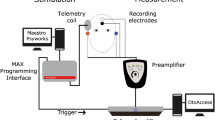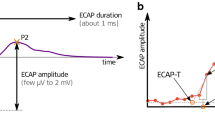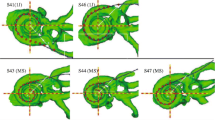Abstract
In uncooperative patients, electrical compound action potential (ECAP) thresholds are reliable in predicting T-levels, but are not in determining the C-level profile. The present study aims to assess if the C-level profile can be predicted by a new objective procedure (C-NRT) which uses the amplitude growth function (AGF) and is based on the assumption that equal ECAP amplitudes elicit equal loudness percepts. This is a correlational study conducted in five tertiary care referral hospitals with 21 post-lingually deaf adult cochlear implant users. Two maps were created: a behavioral, bitonal balanced (BB) map and an objective map, in which T-levels were the same as in the BB map, and C-levels were obtained with C-NRT. C-NRT consisted of performing the AGF of nine electrodes, and of setting the current level eliciting a 100 μV ECAP amplitude as C-level in the map. AutoNRT was also measured. Main outcome measures were correlation between behavioral C-profile level, objective C-profile level, behavioral T-profile level and objective T-profile (AutoNRT) level; disyllabic word recognition scores in quiet and in noise conditions (SNR = + 10 and 0) with both maps. A strong correlation was found between behavioral and C-NRT-derived C-levels (mean per electrode correlation: R = 0.862, p < 0.001). C-NRT could predict behavioral C-levels with a greater accuracy than AutoNRT. Word recognition was significantly better with BB maps only in the quiet condition (p = 0.002). C-NRT is more accurate than AutoNRT in predicting the C-level profile in adult cochlear implant users. This finding encourages future application in uncooperative patients, especially in very young children.


Similar content being viewed by others
References
Hodges A, Balkany T, Ruth R et al (1997) Electrical middle ear muscle reflex: use in cochlear implant programming. Otolaryngol Head Neck Surg 117:255–261
Polak M, Hodges A, Balkany T (2005) ECAP, ESR and subjective levels for two different Nucleus 24 electrode arrays. Otol Neurotol 26:639–645
Brown CJ, Abbas PJ, Borland J et al (1996) Electrically evoked whole nerve action potentials in Ineraid cochlear implant users: responses to different stimulating electrode configurations and comparison to psychophysical responses. J Speech Hear Res 39:453–467
Brown CJ, Hughes ML, Luk B et al (2000) The relationship between EAP and EABR thresholds and levels used to program the Nucleus 24 speech processor: data from adults. Ear Hear 21:151–163
Cullington H (2000) Preliminary neural response telemetry results. Br J Audiol 34:131–140
Hughes ML, Brown CJ, Abbas PJ et al (2000) Comparison of EAP thresholds with MAP levels in the Nucleus 24 cochlear implant: data from children. Ear Hear 21:164–174
Szyfter W, Pruszewicz A, Karlik M et al (2000) First experiences in neural response telemetry in patients with Nucleus 24 cochlear implant system. Otolaryngol Pol 54:337–342
Smoorenburg GF, Willeboer CS, Van Dijk JE (2002) Speech perception in Nucleus CI24M cochlear implant users with processor settings based on electrically evoked compound action potential thresholds. Audiol Neurotol 7:335–347
Potts LG, Skinner MW, Gotter BD et al (2007) Relation between neural response telemetry thresholds, T- and C-levels, and loudness judgments in 12 adult Nucleus 24 cochlear implant recipients. Ear Hear 28:495–511
Franck KH, Norton SJ (2001) Estimation of psychophysical levels using the electrically evoked compound action potential measured with the neural response telemetry capabilities of cochlear corporations CI24M device. Ear Hear 22:289–299
Abbas PJ, Brown CJ, Shallop JK et al (1999) Summary of results using the nucleus CI24M implant to record the electrically evoked compound action potential. Ear Hear 20:45–59
Dillier N, Lai WK, Almqvist B et al (2002) Measurement of the electrically evoked compound action potential via a neural response telemetry system. Ann Otol Rhinol Laryngol 111:407–414
Brown CJ (2003) Clinical uses of electrically evoked auditory nerve and brainstem responses. Otolaryngol Head Neck Surg 11:383–387
Botros A, van Dijk B, Killian M (2007) AutoNRT™: an automated system that measures ECAP thresholds with the Nucleus Freedom™ cochlear implant via machine intelligence. Artif Intell Med 40:15–28
Botros A, Psarros (2010) Neural response telemetry reconsidered: I. The relevance of ECAP threshold profiles and scaled profiles to cochlear implant fitting. Ear Hear 31:367–379
Steel MM, Abbasalipour P, Salloum CA et al (2014) Unilateral cochlear implant use promotes normal-like loudness perception in adolescents with childhood deafness. Ear Hear 35:e291–e301
Teich MC, Lachs G (1979) A neural-counting model incorporating refractoriness and spread of excitation. I. Application to intensity discrimination. J Acoust Soc Am 66:1738–1749
Gallégo S, Garnier S, Micheyl C et al (1999) Loudness growth functions and EABR characteristics in Digisonic cochlear implantees. Acta Otolaryngol 119:234–238
Turrini M, Cutugno F, Maturi P et al (1993) Bisyllabic words for speech audiometry: a new Italian material. Acta Otorhinolaryngol Ital 13:63–77
McKay CM, Fewster L, Dawson P (2005) A different approach to using neural response telemetry for automated cochlear implant processor programming. Ear Hear 26:38S–44S
Alvarez I, de la Torre A, Sainz M et al (2010) Using evoked compound action potentials to assess activation of electrodes and predict C-levels in the Tempo + cochlear implant speech processor. Ear Hear 31:134–145
Holstad BA, Sonneveldt VG, Fears BT et al (2009) Relation of electrically evoked compound action potential thresholds to behavioral T- and C-levels in children with cochlear implants. Ear Hear 30:115–127
Seyle K, Brown CJ (2002) Speech perception using maps based on neural response telemetry measures. Ear Hear 23:72S–79S
Zimmerling MJ, Hochmair ES (2002) EAP recordings in Ineraid patients—correlations with psychophysical measures and possible implications for patient fitting. Ear Hear 23:81–91
Author information
Authors and Affiliations
Corresponding author
Ethics declarations
Conflict of interest
The authors declare they have no conflict of interest.
Ethical approval
All procedures performed in this study involving human participants were in accordance with the ethical standards of the institutional research committees and with the 1964 Helsinki declaration and its later amendments or comparable ethical standards.
Informed consent was obtained from all individual participants included in the study.
Rights and permissions
About this article
Cite this article
Scorpecci, A., D’Elia, A., Malerba, P. et al. Maps created using a new objective procedure (C-NRT) correlate with behavioral, loudness-balanced maps: a study in adult cochlear implant users. Eur Arch Otorhinolaryngol 273, 4167–4173 (2016). https://doi.org/10.1007/s00405-016-4115-1
Received:
Accepted:
Published:
Issue Date:
DOI: https://doi.org/10.1007/s00405-016-4115-1




